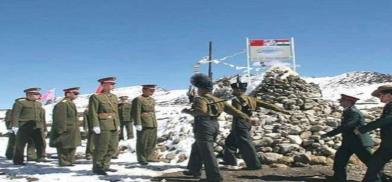Top Indian and Chinese generals meet after two months to resolve LAC standoff
India and China held the 13th round of Corps Commander-level talks on Sunday at Moldo. The meeting, which started around 10.30 am, ended around 7 in the evening, India's Ministry of Defence said

India and China held the 13th round of Corps Commander-level talks on Sunday at Moldo. The meeting, which started around 10.30 am, ended around 7 in the evening, India's Ministry of Defence said.
The Indian delegation was led by Lt Gen P G K Menon, commander of the Leh-based XIV Corps, which is responsible for the Line of Actual Control (LAC) in Ladakh. The Chinese side was headed by Maj Gen Liu Lin, commander of the Xinjiang military district.
Since the standoff began in May 2020, the two sides have disengaged from PP14 in Galwan Valley, PP17A at Gogra Post, and the north and south banks of Pangong Tso.
A small number of Chinese troops continue to be on the Indian side of the LAC near PP15 in Hot Springs. In the Depsang Plains, China is blocking India from accessing its five patrolling points — PP10, PP11, PP11A, PP12, and PP13. Some “so called civilians” from China have pitched tents on the Indian side of the Charding Nala in Demchok, The Indian Express said.
Sunday’s meeting took place after a gap of over two months — the previous round of discussions were held on July 31. Officials were hopeful of an agreement on disengagement from PP15 at the end of the meeting.
China has been investing in infrastructure in its regions facing Ladakh and Arunachal Pradesh. It is testing India’s preparedness with transgressions in middle and eastern sectors, The Indian Expres further said.
The meeting took place amid increasing reports of incursions by the Chinese at various places along the LAC. Indian and Chinese patrols came face-to-face in Tawang a few days ago, and Chinese troops crossed the LAC in Barahoti in Uttarakhand at the end of August. Army Chief General M M Naravane had said on Saturday that China has been building infrastructure in the region, and was “here to stay”.
“It is a matter of concern that the large-scale build-up which had occurred, continued to be in place and to sustain that kind of build-up, there has been an equal amount of infrastructure development on the Chinese side. It means that they’re there to stay,” Gen Naravane had said.
“But if they’re there to stay, we’re there to stay too. And the build-up on our side, and the developments on our side, is as good as what PLA has done.”
Each side has around 50,000 troops in the region, along with additional military equipment, weapons, tanks and air defence assets that were brought in last year.
As winter approaches, the two sides have a window of barely a few weeks to disengage — they will otherwise have to spend a second winter in Ladakh’s brutal conditions. However, unlike the unprecedented deployment through last winter, neither Indian nor Chinese troops are on the frontlines now, or at mountaintops.
Days after the last round of Corps Commander talks on July 31, the two sides had disengaged from PP 17A in the Gogra Post area, with troops moving back to their traditional bases and creating a temporary no-patrol zone. The understanding had come after months of deadlock starting February.
However, China had refused to pull its troops back from PP15 in Hot Springs, where it continues to have a platoon-sized deployment.









Post a Comment